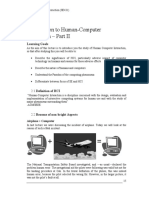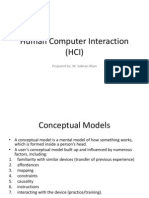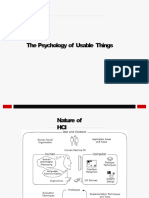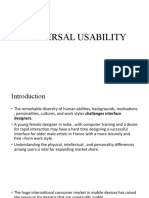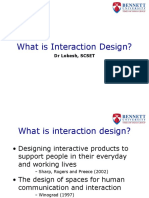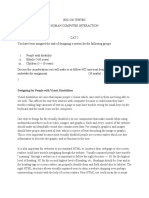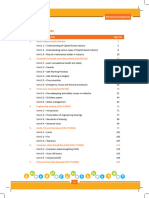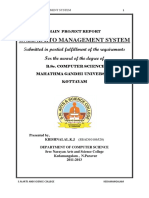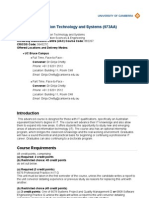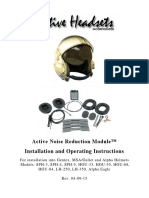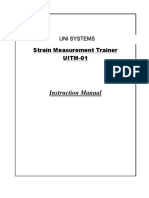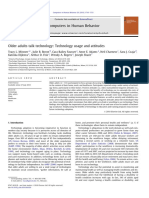Design of Technology
• The Hawthorne studies showed that social factors can be more important than the
physical environment in job performance.
• There is no doubt, however, that the physical features of job settings can affect
performance. The field of human factors (also called ergonomics or engineering
psychology) is concerned with the interface between people and the physical
environment, including tools, equipment, and technology.
• Human factors psychologists are involved in the design of the physical environment
to make jobs safer and easier to accomplish.
• Through their work over the past few decades, human factors psychologists have
developed sound design principles and procedures.
• The influence of the field can be found in the design of everything from automobiles
and consumer appliances to military aircraft and nuclear power plants.
�Displays and Controls
• The major focus of human factors is on the interaction between
people and tools, machines, or technology.
• Two major areas of concern are the presentation of information to
the person and the manipulation of tools or machines by the person.
• In an automobile, the driver must be given information about speed.
• He or she also must control the speed and direction of the vehicle.
Human factors principles tell engineers how best to present
information and design controls that maximize precision and reduce
human error.
�• A machine can provide information to a person in many ways. The
nature and use of the information determine how it should best be
presented. Most machine information is provided through either the
visual or the auditory channel, or sometimes both. For danger or
warning signals, such as at a railway crossing, it is best to use both,
such as a bell and flashing lights.
�• With machines, information can be provided in a visual display.
• Two different types of visual displays for quantitative
information (airplane altitude) are shown in Figure.
• The upper display in the figure is a two-point style, which is
like a traditional clock with the shorter and heavier hand
representing altitude in thousands of feet and the longer and
thinner hand representing hundreds of feet.
• The lower display is a digital display, which indicates the
altitude by showing the numerals. Obviously, in an airplane
there is a need to be able to determine altitude both quickly
and accurately because errors can lead to disaster.
• The digital display is superior to the two-point because it is
easy to mix up the two hands (Buck, 1983). For example, 2,100
feet can be misread as 1,200 feet, which could present a
problem for anyone attempting to fly over a 2,000-foot-high
mountain
�• The manipulation of the machine by the person, often in response to
information provided by a display, is accomplished through controls.
• The design of the best control is also determined by the particular purpose
and situation.
• Most controls are worked with either the hand or the foot, although other
possibilities can be found (e.g., the knee or elbow).
• Hand controls are best when fine or precise motions are necessary, such as
for steering an automobile. Foot controls are best when force is more
important than precision, such as with a brake pedal for an automobile
�• There are a number of important design considerations pertaining to
controls. First, they should be located in a logical place, with controls
for the same function together. A well-designed automobile console,
for example, will place the lighting controls together, the windshield
wiper and washer controls together, the heater and air conditioner
controls together, and so on. A control to work a front window should
be in front of a control to work a back window, and a control to work
a feature on the right side of the car should be to the right of a
control to work the same feature on the left side.
�• Second, vital controls that can produce important consequences
should be recognizable by touch. This is not important for the volume
control on a car radio, but it is vital for the landing gear on an
airplane.
• Example: several different knobs for stick-type levers, such as the shift
lever of an automobile. Each of these can be discriminated by touch
alone.
�• Third, controls should provide appropriate feedback so that the person knows that
the function has been accomplished (Wickens, Lee, Liu, & Becker, 2004).
• With an on/off switch, the person might hear a click and feel a tactile sensation
indicating that the switch has been activated or deactivated. Some switches use
springs so that the person can feel the lever lock into place.
• Finally, the directions in which controls are moved should logically match the
directions in which the machine will move.
• For example, an increase in some factor should involve moving a switch either
clockwise, up, or to the right as opposed to counterclockwise, down, or to the left.
• This is the general rule followed with most equipment with volume controls, such as
radios and televisions. Levers to move a device to the right should move clockwise
or to the right, as in most vehicles.
�Computer-Human Interaction
• These principles of displays and controls have been available for many years,
so there is not much need to conduct research on them today. Instead, human
factors psychologists have turned their attention to computer-human
interaction.
• Computer-human interaction is the interplay of people with computers and
associated technologies that have led to tremendous changes in the workplace
for both blue- and white-collar work.
• Automation and computerization have changed the nature of many jobs, so
that individuals must use computer-based systems to accomplish a growing
number of tasks.
• Web-based systems are rapidly replacing physical paper-and-pencil systems for
many tasks, such as paying bills.
�• A major issue for computer-human interaction is communication
between human and machine. That is, how best should computers
provide information to people, and how best can people tell
computers what they wish done? In order for people to communicate
effectively with computers, they must develop a conceptual
understanding or mental model of how the computer operates
(Wickens et al., 2004). A person who knows how to drive an
automobile, for example, has a mental model of how the operation of
the controls results in the appropriate movement of the vehicle
�• The principles of human factors can be used to design tools and
equipment so that people can perform their tasks more easily and
efficiently. Whether or not this translates into better overall task
performance depends on many other factors. If employees are not
motivated to perform well, making their job tasks easier through
better equipment design might mean that they do the same work
with less effort. Furthermore, constraints in the work environment,
which we discuss next, may prevent better performance, even though
certain tasks might be accomplished more efficiently
�• From a human factors perspective, the goal is to design technology
that will be helpful to people. However, technology can come with a
price, and not all effects are positive. The introduction of computers
in manufacturing has changed jobs but not always for the better.
Although new factory systems might be more efficient, they can
increase employee boredom and stress. Often the person who used
to be an active participant on the assembly line is relegated to
passively watching a machine operate. The loss of control over tasks
to the machine can be associated with job dissatisfaction and poor
emotional well-being.









